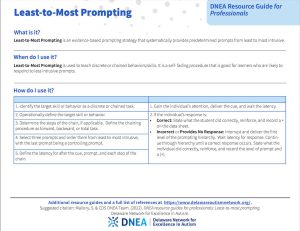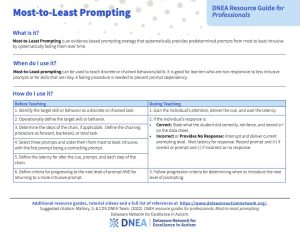Archives: Resources

Least-to-Most Prompting is an evidence-based prompting strategy that systematically provides predetermined prompts from least to most intrusive. It can be used to teach discrete or chained behaviors/skills.
This short video was produced by the Delaware Network for Excellence in Autism (DNEA) team at the University of Delaware’s Center for Disabilities Studies. In this video, we will talk about the importance of using visual supports in medical settings for individuals with autism. Visual supports help clarify expectations in medical settings by making foreign concepts like medical procedures more predictable and understandable.
This prompting tutorial reviews how to support teaching a person with autism a new skill or task. This tutorial has been designed to support professionals and family members using the evidence-based practice of least to most prompting which is appropriate to use across multiple settings. Most to least prompting can be used to teach both discrete and chained skills. When using least to most prompting, prompts are systematically provided from the least intrusive to the most intrusive.
Join the Delaware Network for Excellence in Autism (DNEA) as they host Dr. Priya Lalvani as she discusses ableism and what it means to disrupt it. This webinar discusses ableism, how discrimination against people with disabilities is embedded in our language and culture, and how professionals and families can become allies for disability justice.
Dr. Lalvani has a Ph.D. in developmental psychology and is a professor at Montclair State University. She teaches courses in Disabilities Studies and is the coordinator for the graduate programs in inclusive education. Through her research, she seeks to confront ableism in schools and society and to problematize the practice of segregated education for many students with disabilities in schools. She is the co-author of the book: Undoing Ableism: Teaching About Disability in K-12 Classrooms and the editor of Constructing the (M)other with Narratives of Disability, Motherhood, and the Politics of Normal.

Most-to-Least Prompting is an evidence-based prompting strategy that systematically provides predetermined prompts from most to least intrusive by systematically fading them over time. It can be used to teach discrete or chained behaviors/skills.
This prompting tutorial reviews how to support teaching a person with autism a new skill or task. This tutorial has been designed to support professionals and family members using the evidence-based practice of most to least prompting which is appropriate to use across multiple settings. Most to least prompting can be used to teach both discrete and chained skills. When using most to least prompting, prompts are systematically provided from the most intrusive to the least intrusive.

Wong, et al. (2015) conducted a comprehensive review of research about focused intervention practices to support individuals with autism. This comprehensive review is considered a landmark article because it identifies those strategies that are most effective to use with autistic people. This glossary is designed to support the community in understanding terms commonly associated with these practices.
Brought to you by the Delaware Network for Excellent in Autism (DNEA), this social skills instruction training discusses social skills developed and how that development can look different for students with autism. The training considers ways of assessing social skills, skills to target and explores evidence-based strategies that can support autistic students.
This content was developed as part of a collaboration between the Delaware Department of Education, Delaware Office of Statewide Autism Programs, and Delaware Network for Excellence in Autism at the University of Delaware Center for Disabilities Studies.
Brought to you by the Delaware Network for Excellent in Autism (DNEA), this classroom management training discusses the challenges of traditional classroom management practices and autism and explore evidence-based strategies that can support autistic students.
This content was developed as part of a collaboration between the Delaware Department of Education, Delaware Office of Statewide Autism Programs, and Delaware Network for Excellence in Autism at the University of Delaware Center for Disabilities Studies.
Brought to you by the Delaware Network for Excellence in Autism (DNEA), this prompting tutorial reviews how to support teaching a person with autism a new skill or task. This tutorial has been designed to support professionals and family members using the evidence-based practice of prompting which is appropriate to use across multiple settings.

